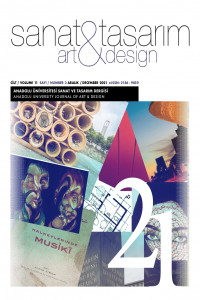Öz
Bu makalede, İran doğumlu sanatçı Shirin Neshat’ın, 1993-1997 yılları arasında gerçekleştirmiş olduğu Allah’ın Kadınları adlı fotoğraf serisinden, “Şehit Arayan#2” fotoğrafı, dönem ve sanatçı bağlamında politik ve kültürel kodları üzerinden analiz edilmeye çalışılmıştır. Tarihsel gelişim sürecinde toplumların yaratmış oldukları değerler bütünü içerisinde oldukça önemli bir yer tutan din ve politika Shirin Neshat yapıtlarında birbiriyle örüntülü iki temel unsurdur. İran halkının duyuş ve düşünüş biçimine dair önemli veriler barındıran bu iki olgu Neshat’ın yapıtlarında Doğu’ya dair derin izlekler taşır. Sanatçı, merkezine kendi bedenini yerleştirdiği kurgularında silah ve lale gibi İran kültüründe özel anlamlar barındıran metaforik imgeler kullanırken, Fars kaligrafisiyle bedenin açıkta kalan bazı bölgelerini İran’ın iki önemli kadın şairinin dizeleriyle bezer. Neshat çalışmalarında, İslam dünyasının Şii geleneğini, bu geleneğin içeriğinde barındırdığı ritüellerden kesitler alarak, anıtsal fotoğraflar eşliğinde yorumlar. Doğu’da dünyaya gelen, gençlik yıllarından itibaren yaşamını Amerika’da sürdüren çift kimlikli sanatçı, bu seride adeta kendi yarattığı dilde Doğu’yu Batı’ya anlatır. Çalışmada, nitel araştırma yöntemi ile literatür taraması yapılarak, metaforik imgeler aracılığıyla kurgulanmış temsil üzerinden, belli bir dönemin belli bir coğrafyasında, bedeninin ürettiği politik ve kültürel kodlara odaklanılmıştır.
Kaynakça
- • Bourdieu, Pierre. (2015). Eril Tahakküm. (B. Yılmaz, Çev.). İstanbul: Bağlam Yayıncılık
- • Eco, U. (1992). Açık Yapıt. (Y. Şahan, Çev.). İstanbul: Kabalcı Yayınları
- • Ferruhzad, F. (2015). Yeryüzü Ayetleri. (M. Aras, Çev.). İstanbul: Can Yayınları
- • Heritage Auctions. Shirin Neshat. (1995). Seeking Martyrdom#1. Erişim: 03.02.2021 https://cutt.ly/lkgrNVW
- • Horkheimer, M. (1998). Akıl Tutulması. (O. Koçak, Çev.). İstanbul: Metis Yayınları
- • İzinsiz Gösteri. (2006). Shirin Neshat ve Allah’ın Kadınları, Sayı:71. Erişim: 02.02.2021. http://www.izinsizgosteri.net/ salsayi71/kubilay.akman.2_71.html
- • Gladstone Gallery. Macdonald, Scott. (2004). Between Two Worlds: An Interwiev with Shirin Neshat. Feminist Studies 30, No:3 (621-657), Erişim: 03.02.2021. https://cutt.ly/QkdRTrs
- • EsearchGate. Mottahedeh, Negar. (2003). After-Images of Revolution. Radical History Review 86, (183-192), Erişim: 03.02.2021. https://cutt.ly/kkdSx8o
- • Routledge: Taylor & Francis. Vitali, Valentina. (2010). Corporate Art and Critical Theory: On Shirin Neshat. Women: A Cultural Review. Cilt:15, Sayı:1 (1-18). Erişim: 03.02.2021. https://cutt.ly/AkdDGNc
- • Sadak, B. (2011). Kur’an-ı Kerim ve Türkçe Anlatımı. İstanbul: Marmara Üniversitesi İlahiyat Fakültesi Vakfı Yayınları
- • Sayın, Z. (2015). İmgenin Pornografisi. İstanbul: Metis
- • Yörüker, S. (2006). Shirin Neshat Sanatında Kimlik, Beden, Yazı. Yüksek Lisans Tezi. Mimar Sinan Güzel Sanatlar Üniversitesi, Sosyal Bilimler Enstitüsü, Sanat Tarihi Anabilim Dalı.
Öz
In this article, the photograph of “Martyr Seeker # 2” from the series of photographs entitled Women of God, realized by the Iranian-born artist Shirin Neshat between 1993-1997, is tried to be analyzed in the context of the period and artist through its political and cultural codes. Religion and politics, which have an important place in the set of values created by societies in the historical development process, are the two basic elements that are patterned with each other in Shirine Neshat’s works. These two phenomena, which contain important data on the way of feeling and thinking of the Iranian people, carry deep themes about the East in Neshat’s works. While the artist uses metaphorical images such as weapons and tulips that have special meanings in Iranian culture in her fictions, where she places her own body at the center, she uses Persian calligraphy to decorate some of the exposed parts of the body with the lines of two important Iranian women poets. In her works, Neshat interprets the Shia tradition of the Islamic world with monumental photographs by taking sections from the rituals that this tradition contains. The artist with dual identity, who was born in the East and has been living in America since her youth, literally tells the East to the West in the language she created in this series. The study focuses on the political and cultural codes produced by the body in a certain geography of a certain period through the representation constructed through metaphorical images by scanning the literature with the qualitative research method.
Anahtar Kelimeler
Kaynakça
- • Bourdieu, Pierre. (2015). Eril Tahakküm. (B. Yılmaz, Çev.). İstanbul: Bağlam Yayıncılık
- • Eco, U. (1992). Açık Yapıt. (Y. Şahan, Çev.). İstanbul: Kabalcı Yayınları
- • Ferruhzad, F. (2015). Yeryüzü Ayetleri. (M. Aras, Çev.). İstanbul: Can Yayınları
- • Heritage Auctions. Shirin Neshat. (1995). Seeking Martyrdom#1. Erişim: 03.02.2021 https://cutt.ly/lkgrNVW
- • Horkheimer, M. (1998). Akıl Tutulması. (O. Koçak, Çev.). İstanbul: Metis Yayınları
- • İzinsiz Gösteri. (2006). Shirin Neshat ve Allah’ın Kadınları, Sayı:71. Erişim: 02.02.2021. http://www.izinsizgosteri.net/ salsayi71/kubilay.akman.2_71.html
- • Gladstone Gallery. Macdonald, Scott. (2004). Between Two Worlds: An Interwiev with Shirin Neshat. Feminist Studies 30, No:3 (621-657), Erişim: 03.02.2021. https://cutt.ly/QkdRTrs
- • EsearchGate. Mottahedeh, Negar. (2003). After-Images of Revolution. Radical History Review 86, (183-192), Erişim: 03.02.2021. https://cutt.ly/kkdSx8o
- • Routledge: Taylor & Francis. Vitali, Valentina. (2010). Corporate Art and Critical Theory: On Shirin Neshat. Women: A Cultural Review. Cilt:15, Sayı:1 (1-18). Erişim: 03.02.2021. https://cutt.ly/AkdDGNc
- • Sadak, B. (2011). Kur’an-ı Kerim ve Türkçe Anlatımı. İstanbul: Marmara Üniversitesi İlahiyat Fakültesi Vakfı Yayınları
- • Sayın, Z. (2015). İmgenin Pornografisi. İstanbul: Metis
- • Yörüker, S. (2006). Shirin Neshat Sanatında Kimlik, Beden, Yazı. Yüksek Lisans Tezi. Mimar Sinan Güzel Sanatlar Üniversitesi, Sosyal Bilimler Enstitüsü, Sanat Tarihi Anabilim Dalı.
Ayrıntılar
| Birincil Dil | Türkçe |
|---|---|
| Bölüm | Makaleler |
| Yazarlar | |
| Yayımlanma Tarihi | 27 Aralık 2021 |
| Yayımlandığı Sayı | Yıl 2021 Cilt: 11 Sayı: 2 |


